Wedding Feast at Cana

by Paolo Caliari, “The Veronese”, 1563.
This painting measures almost 70 square meters, being the largest one preserved in a French museum. 132 figures are represented in the scene, showing the first miracle of Christ: turning water into wine at a wedding feast in Cana. The painting was commissioned for the refectory of San Giorgio Maggiore, in Venice.
The painting hangs in the dining room of the building you are currently visiting since 1798, after having been plundered by Napoleon I from the Monastery where it belonged. It is spectacular not only in terms of scale, but also in terms of the artist's treatment of space and color. It is a theatrical scene that portrays each figure in the Italian fashion of the 16th century and not in clothes that go back to antiquity.
Veronese, who was specialized in decorative painting, represents the Religious scene in all the decadence of a Venetian banquet, including interesting symbols. Above the head of Christ, a group of men can be seen cutting flesh, which represents the sacrifice of Christ for humanity; at the banquet table, guests are eating fruits such as quinces, which are a symbol of marriage.
Interestingly, the only two figures that look directly at the viewer, are Christ and the bride. Jesus is placed in the middle of the composition, and the bride at the left bottom of the banquet table. Can you find her? Her husband is sitting next to her and someone is serving him a glass of wine.
Directly in front of Christ, there is a group of musicians. Veronese paints himself as one of them, wearing beautiful white silk clothes and being thus more visible than Christ himself! Moreover, there are other contemporaries of the artist who exchange their brushes for instruments in the scene, such as Tintoretto, Bassano and Titian.
During the World War II, the painting was transferred to the South of France to be protected, which explains that it could be carried out easily despite its size.
© ChatGPT 3.5